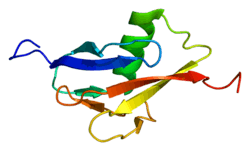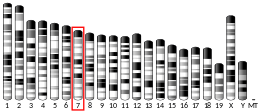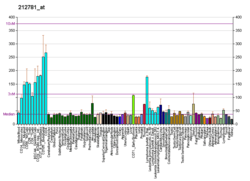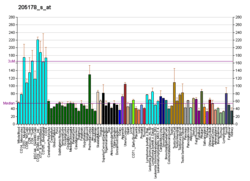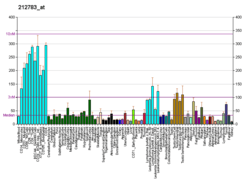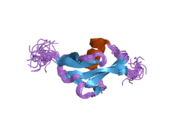RBBP6
Retinoblastoma-binding protein 6 is a protein that in humans is encoded by the RBBP6 gene.[5][6][7]
Function
The retinoblastoma tumor suppressor (pRB) protein binds with many other proteins. In various human cancers, pRB suppresses cellular proliferation and is inactivated. Cell cycle-dependent phosphorylation regulates the activity of pRB. This gene encodes a protein which binds to underphosphorylated but not phosphorylated pRB. Multiple alternatively spliced transcript variants that encode different isoforms have been found for this gene.[7]
Interactions
RBBP6 has been shown to interact with Y box binding protein 1.[8]
gollark: If you have suggestions, please do tell me them.
gollark: Don't we all?
gollark: Yes.
gollark: Look, if you have other ideas, just tell me them.
gollark: HAXXX!#
References
- GRCh38: Ensembl release 89: ENSG00000122257 - Ensembl, May 2017
- GRCm38: Ensembl release 89: ENSMUSG00000030779 - Ensembl, May 2017
- "Human PubMed Reference:". National Center for Biotechnology Information, U.S. National Library of Medicine.
- "Mouse PubMed Reference:". National Center for Biotechnology Information, U.S. National Library of Medicine.
- Sakai Y, Saijo M, Coelho K, Kishino T, Niikawa N, Taya Y (Nov 1995). "cDNA sequence and chromosomal localization of a novel human protein, RBQ-1 (RBBP6), that binds to the retinoblastoma gene product". Genomics. 30 (1): 98–101. doi:10.1006/geno.1995.0017. PMID 8595913.
- Pugh DJ, Ab E, Faro A, Lutya PT, Hoffmann E, Rees DJ (Feb 2006). "DWNN, a novel ubiquitin-like domain, implicates RBBP6 in mRNA processing and ubiquitin-like pathways". BMC Structural Biology. 6: 1. doi:10.1186/1472-6807-6-1. PMC 1360078. PMID 16396680.
- "Entrez Gene: RBBP6 retinoblastoma binding protein 6".
- Chibi M, Meyer M, Skepu A, G Rees DJ, Moolman-Smook JC, Pugh DJ (Dec 2008). "RBBP6 interacts with multifunctional protein YB-1 through its RING finger domain, leading to ubiquitination and proteosomal degradation of YB-1". Journal of Molecular Biology. 384 (4): 908–16. doi:10.1016/j.jmb.2008.09.060. PMID 18851979.
Further reading
- Simons A, Melamed-Bessudo C, Wolkowicz R, Sperling J, Sperling R, Eisenbach L, Rotter V (Jan 1997). "PACT: cloning and characterization of a cellular p53 binding protein that interacts with Rb". Oncogene. 14 (2): 145–55. doi:10.1038/sj.onc.1200825. PMID 9010216.
- Gao S, Witte MM, Scott RE (May 2002). "P2P-R protein localizes to the nucleolus of interphase cells and the periphery of chromosomes in mitotic cells which show maximum P2P-R immunoreactivity". Journal of Cellular Physiology. 191 (2): 145–54. doi:10.1002/jcp.10084. PMID 12064457.
- Colland F, Jacq X, Trouplin V, Mougin C, Groizeleau C, Hamburger A, Meil A, Wojcik J, Legrain P, Gauthier JM (Jul 2004). "Functional proteomics mapping of a human signaling pathway". Genome Research. 14 (7): 1324–32. doi:10.1101/gr.2334104. PMC 442148. PMID 15231748.
- Beausoleil SA, Jedrychowski M, Schwartz D, Elias JE, Villén J, Li J, Cohn MA, Cantley LC, Gygi SP (Aug 2004). "Large-scale characterization of HeLa cell nuclear phosphoproteins". Proceedings of the National Academy of Sciences of the United States of America. 101 (33): 12130–5. doi:10.1073/pnas.0404720101. PMC 514446. PMID 15302935.
- Yoshitake Y, Nakatsura T, Monji M, Senju S, Matsuyoshi H, Tsukamoto H, Hosaka S, Komori H, Fukuma D, Ikuta Y, Katagiri T, Furukawa Y, Ito H, Shinohara M, Nakamura Y, Nishimura Y (Oct 2004). "Proliferation potential-related protein, an ideal esophageal cancer antigen for immunotherapy, identified using complementary DNA microarray analysis". Clinical Cancer Research. 10 (19): 6437–48. doi:10.1158/1078-0432.CCR-04-0841. PMID 15475430.
- Scott RE, White-Grindley E, Ruley HE, Chesler EJ, Williams RW (Jul 2005). "P2P-R expression is genetically coregulated with components of the translation machinery and with PUM2, a translational repressor that associates with the P2P-R mRNA". Journal of Cellular Physiology. 204 (1): 99–105. doi:10.1002/jcp.20263. PMID 15617101.
- Beausoleil SA, Villén J, Gerber SA, Rush J, Gygi SP (Oct 2006). "A probability-based approach for high-throughput protein phosphorylation analysis and site localization". Nature Biotechnology. 24 (10): 1285–92. doi:10.1038/nbt1240. PMID 16964243.
- Olsen JV, Blagoev B, Gnad F, Macek B, Kumar C, Mortensen P, Mann M (Nov 2006). "Global, in vivo, and site-specific phosphorylation dynamics in signaling networks". Cell. 127 (3): 635–48. doi:10.1016/j.cell.2006.09.026. PMID 17081983.
This article is issued from Wikipedia. The text is licensed under Creative Commons - Attribution - Sharealike. Additional terms may apply for the media files.
